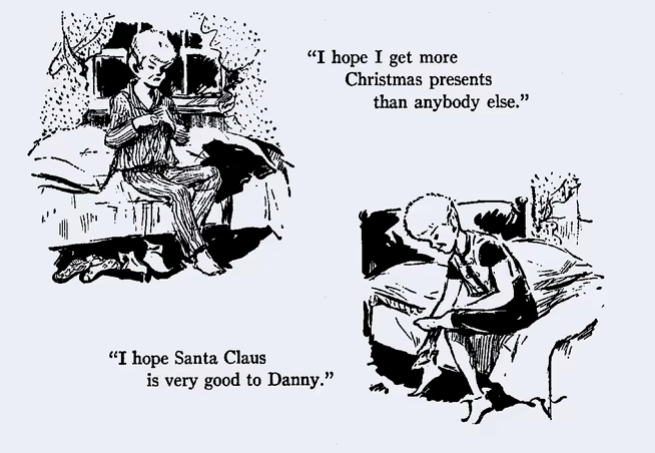The boys are prepubescent, but their exact age is unclear, as is their relationship to each other … Are they twin brothers? Friends? The same kid in alternate universes? Or is it more of a Jekyll-and-Hyde situation?
It doesn’t really matter. Goofus and Gallant are symbols more than characters. In every issue, they play out a sort of Calvinist destiny. Their essential nature was preordained by a higher power long ago—Goofus forever doomed to be a screwup, Gallant to be a smug little do-gooder.

The higher power that created them was Garry Cleveland Myers, who first wrote a version of the strip called “The G-Twins” at the magazine Children’s Activities, before he co-founded Highlights with his wife, Caroline Clark Myers. But in another sense the characters sprang directly from the moral compass of society.
Since 1948, Goofus and Gallant, the stars of their eponymous comic strip in Highlights for Children magazine, have taught generations of kids the dos and don’ts of how to be.
Julie Beck, at The Atlantic, spent some time at the Library of Congress reading decades of Goofus and Gallant strips taking special note of the changing customs and mores through the past 75 years of Highlights for Children, and then discussed the changing attitudes with Christine French Cully, Highlights’ current editor in chief.

Every installment of Goofus and Gallant now has a line at the top that reads “There’s some of Goofus and Gallant in us all. When the Gallant shines through, we show our best self.”
Some recent (2018) samples of Goofus and Gallant.
From Mental Floss (2017): 7 Engaging Facts About Goofus and Gallant
3. ONE ARTIST DREW THE STRIP FOR 32 YEARS.
Once Myers secured the rights to the two characters for Highlights, he enlisted illustrator Marion Hull Hammel to draw their adventures (and misadventures), taking them from the elfin creatures of the early days to the human boys of the 1950s and beyond. Hammel wound up drawing it for 32 years; Sidney Quinn took over when she retired and worked on it through 1995. Current artist Leslie Harrington has been on the strip since 2006.
Update: Made a stop at Barnes and Noble today and checked the June 2023 issue of Highlights for Children – Leslie Harrington remains the credited illustrator.


I remember them so well. I always liked that feature, and thought it made a lot of sense. However, smiling when bleeding being a positive trait seems a bit harsh. I had a “Highlights” subscription for five years, and read it in my dentist’s office waiting room before that. I will read the article about how Goofus and Gallant changed with the times.
Smiling while bleeding sounds harsh but very of its time.
It’s not about smiling while bleeding or being hurt It’s about dramatizing a minor injury to and for what end. Attention seeking. Remember the boy who cried wolf? It’s called suck it up walk it off and get on with life. It’s about building strength of character however simply portrayed in this cartoon. Also learning to think outside the box. Cry babies will never be leaders and excuse makers and distorters of reality are why we have our current administration.
Trump administration I assume
I always thought of them as two boys who may or may not know each other.
This sounds like a neat article (I’ve used up my free Atlantic articles, though so I’ll have to find a way around that.). I’ve come across vintage copies of Highlights once in a while and it’s always interesting to see what was considered “bad behavior” in the past—the one I have showed Goofus letting the bar of soap melt in the bathtub (Dad’s not made of money!)
Abby, MSN now has the article up on their site:
https://www.msn.com/en-us/news/opinion/the-comic-strip-that-explains-the-evolution-of-american-parenting/ar-AA1d9hJ1
I refuse to be looked down upon for not liking milk.
This is understandable. It wasn’t until the ’60s that researchers determined that “lactose intolerance” was even a thing. Before that, while some people have gotten gas for thousands of years from dairy, before that, it was deemed a “milk allergy,” or simply “wind.” (Note that RIVERDALE, currently set in 1955, used the term last week, anachronistically. But they also used “teeny bopper” (1965) and “beatnik” (1958), which has been happening repeatedly since this season, is probably all happening in Jughead’s mind–so they can attribute it all to his own ignorance of detailed American history. After all, his memory had 1965’s Righteous Brothers version of “Unchained Melody” instead of one of the actual 1955 versions (by Roy Hamilton or Al Hibbler) playing during multiple prom scenes a few weeks back. But then, RIVERDALE has never made any since since it started, quite unlike the absolute stark realism of Archie Comics since 1941.
Given the boys were originally drawn as elves, it’s obvious they are changelings — with Gallant growing up to become that rat fink Elf on the Shelf, and Goofus obviously becoming the 45th president.
Did Dan Perkins subscribe to “Highlights”? It seems that once the boys hit puberty they morphed into Goofball and Galahad, and their outlooks on life (and politics, of course) seem to have switched poles.
I wonder if you remember these other Highlights cartoon strips besides Goofus and Gallant:
“The Bear Family”
“The Timbertoes”
I wasn’t much of a Highlights tyke, so when you mentioned Timbertoes
my mind went straight to B. K. Taylor’s Timberland Tales.
https://finleyquality.net/timberland-tales/
Yes, but where are they now?
https://www.mcsweeneys.net/articles/goofus-gallant-rashomon
That’s hilarious, thanks for the link and laugh.